Do you have a question about the TCL TAC-07CS and is the answer not in the manual?
Provides instructions for ordering spare parts, including required information.
Diagram illustrating the refrigerating cycle for heat pump operation.
Diagram illustrating the refrigerating cycle for cooling only operation.
Detailed steps for vacuuming the refrigerant system.
Procedure for measuring indoor air wet-bulb/dry-bulb temperature difference.
Instructions for setting the remote controller to Cooling Only or Heat Pump mode.
Details on compressor time delay, frost prevention, and high temperature protection.
Explanation of the "I Feel" mode operation and temperature adjustment.
Description of cooling mode operation and initial set temperatures.
Details on the system's operation in DRY mode.
Description of heating mode operation and cold air prevention control.
Conditions for defrost starting and terminating, and defrosting time chart.
Explanation of the assistant thermistor's role in heating capacity.
Operation of the 4-way valve for cooling/heating modes.
Details on setting and operation of the SLEEP mode.
Explanation of rotational frequency feedback and auto fan speed control.
Control of vane motor for angle and mode selection.
Instructions for setting and cancelling timer functions.
Procedure for emergency test operation when remote is missing or failed.
Description of the auto restart function for power failure recovery.
Checks for failure in heat sensitive components.
Details on outdoor unit protection mechanisms.
Information on failure codes and lamp indications.
Steps to handle specific failures like sensor or protection issues.
Schematic of the indoor unit's internal wiring connections.
Schematic of the outdoor unit's internal wiring connections.
Exploded view diagram of the indoor unit components.
Exploded view diagram of the outdoor unit components.
Parts list for Indoor Unit models TAC-07CS/K and TAC-09CS/K.
Parts list for Indoor Unit models TAC-07CHS/K and TAC-09CHS/K.
Parts list for Indoor Unit models TAC-07CSC/K and TAC-09CSC/K.
Parts list for Indoor Unit models TAC-07CHSC/K and TAC-09CHSC/K.
Parts list for Indoor Unit models TAC-12CS/K and TAC-12CSC/K.
Parts list for Indoor Unit models TAC-12CHS/K and TAC-12CHSC/K.
Parts list for Indoor Unit models TAC-18CS/K, TAC-18CSC/K, TAC-24CS/K, TAC-24CSC/K.
Parts list for Indoor Unit models TAC-18CHS/K, TAC-18CHSC/K, TAC-24CHS/K, TAC-24CHSC/K.
Parts list for Outdoor Unit models TAC-07CS/K and TAC-09CS/K.
Parts list for Outdoor Unit models TAC-07CSC/K and TAC-09CSC/K.
Parts list for Outdoor Unit models TAC-07CHS/K and TAC-09CHS/K.
Parts list for Outdoor Unit model TAC-12CS/K.
Parts list for Outdoor Unit model TAC-12CSC/K.
Parts list for Outdoor Unit model TAC-12CHS/K.
Parts list for Outdoor Unit model TAC-12CHSC/K.
Parts list for Outdoor Unit model TAC-18CS/K.
Parts list for Outdoor Unit model TAC-18CSC/K.
Parts list for Outdoor Unit model TAC-18CHS/K.
Parts list for Outdoor Unit model TAC-18CHSC/K.
Parts list for Outdoor Unit model TAC-24CS/K.
Parts list for Outdoor Unit model TAC-24CSC/K.
Parts list for Outdoor Unit model TAC-24CHS/K.
Parts list for Outdoor Unit model TAC-24CHSC/K.
Parts list for Outdoor Unit model TAC-24CHSC/K.
Classification of air conditioners based on function and installation type.
Defines temperature, humidity, purity, and airflow in air conditioning.
Explains the basic principle of how refrigeration cycles work.
Detailed diagram and explanation of the refrigerating cycle stages.
Defines key terms used in air conditioning, including thermal flow.
Explains units of measurement like Kcal, BTU, RT, Hp, and conversion tables.
Defines components like compressor, condenser, evaporator, dryer, and valves.
Explanation of refrigerant state transitions on the Mollier diagram.
Explains the psychrometric chart and its use in determining air conditions.
Describes dewing and methods to prevent it, with humidity tables.
Details on sound composition, attenuation, and allowable noise levels.
Guidance on calculating cooling and heating loads.
Methods for selecting the appropriate air conditioner capacity.
Chart for determining unit size based on cooling capacity requirements.
Checks for power supply, voltage drop, wire capacity, and internal components.
Inspection of insulation resistance, running capacitor, and motor fan.
Troubleshooting steps for electrical and mechanical compressor issues.
Checks for refrigerant issues like short, closing, overcharge, and bad compression.
Safety and procedural precautions for performing repairs.
Troubleshooting flowchart for when the product does not operate.
Troubleshooting flowchart for when the room fan does not operate.
Troubleshooting for compressor or outdoor fan non-operation.
Troubleshooting steps for up/down vane malfunctions.
Troubleshooting steps for left/right louver malfunctions.
Troubleshooting for disabled function settings via remote control.
Troubleshooting for problems with cooling/heating mode conversion.
Properties and characteristics of R-407c refrigerant.
Comparison of R-407c and R22 refrigerants regarding charging and properties.
Installation instructions specific to wall-mounted split type air conditioners.
General guidelines including refrigerant characteristics and tools required.
List of essential tools and accessories for air conditioner installation.
Guidance on selecting optimal locations for indoor and outdoor units.
Specifications for piping length and elevation differences between units.
Instructions for fixing the installation plate and drilling wall holes.
Detailed procedures for pipe cutting, burr removal, flaring, and checking.
Steps for routing and connecting indoor unit piping, drain hose, and cables.
Procedures for connecting pipes and drain hose to the outdoor unit.
Instructions for connecting cables between indoor and outdoor units.
Detailed steps for connecting the cable to the outdoor unit.
Checks for drainage and forming piping, including drain hose routing.
Steps for air purging, leak testing, and evacuation using a vacuum pump.
Procedure for test running the unit and evaluating its performance.
Provides instructions for ordering spare parts, including required information.
Diagram illustrating the refrigerating cycle for heat pump operation.
Diagram illustrating the refrigerating cycle for cooling only operation.
Detailed steps for vacuuming the refrigerant system.
Procedure for measuring indoor air wet-bulb/dry-bulb temperature difference.
Instructions for setting the remote controller to Cooling Only or Heat Pump mode.
Details on compressor time delay, frost prevention, and high temperature protection.
Explanation of the "I Feel" mode operation and temperature adjustment.
Description of cooling mode operation and initial set temperatures.
Details on the system's operation in DRY mode.
Description of heating mode operation and cold air prevention control.
Conditions for defrost starting and terminating, and defrosting time chart.
Explanation of the assistant thermistor's role in heating capacity.
Operation of the 4-way valve for cooling/heating modes.
Details on setting and operation of the SLEEP mode.
Explanation of rotational frequency feedback and auto fan speed control.
Control of vane motor for angle and mode selection.
Instructions for setting and cancelling timer functions.
Procedure for emergency test operation when remote is missing or failed.
Description of the auto restart function for power failure recovery.
Checks for failure in heat sensitive components.
Details on outdoor unit protection mechanisms.
Information on failure codes and lamp indications.
Steps to handle specific failures like sensor or protection issues.
Schematic of the indoor unit's internal wiring connections.
Schematic of the outdoor unit's internal wiring connections.
Exploded view diagram of the indoor unit components.
Exploded view diagram of the outdoor unit components.
Parts list for Indoor Unit models TAC-07CS/K and TAC-09CS/K.
Parts list for Indoor Unit models TAC-07CHS/K and TAC-09CHS/K.
Parts list for Indoor Unit models TAC-07CSC/K and TAC-09CSC/K.
Parts list for Indoor Unit models TAC-07CHSC/K and TAC-09CHSC/K.
Parts list for Indoor Unit models TAC-12CS/K and TAC-12CSC/K.
Parts list for Indoor Unit models TAC-12CHS/K and TAC-12CHSC/K.
Parts list for Indoor Unit models TAC-18CS/K, TAC-18CSC/K, TAC-24CS/K, TAC-24CSC/K.
Parts list for Indoor Unit models TAC-18CHS/K, TAC-18CHSC/K, TAC-24CHS/K, TAC-24CHSC/K.
Parts list for Outdoor Unit models TAC-07CS/K and TAC-09CS/K.
Parts list for Outdoor Unit models TAC-07CSC/K and TAC-09CSC/K.
Parts list for Outdoor Unit models TAC-07CHS/K and TAC-09CHS/K.
Parts list for Outdoor Unit model TAC-12CS/K.
Parts list for Outdoor Unit model TAC-12CSC/K.
Parts list for Outdoor Unit model TAC-12CHS/K.
Parts list for Outdoor Unit model TAC-12CHSC/K.
Parts list for Outdoor Unit model TAC-18CS/K.
Parts list for Outdoor Unit model TAC-18CSC/K.
Parts list for Outdoor Unit model TAC-18CHS/K.
Parts list for Outdoor Unit model TAC-18CHSC/K.
Parts list for Outdoor Unit model TAC-24CS/K.
Parts list for Outdoor Unit model TAC-24CSC/K.
Parts list for Outdoor Unit model TAC-24CHS/K.
Parts list for Outdoor Unit model TAC-24CHSC/K.
Parts list for Outdoor Unit model TAC-24CHSC/K.
Classification of air conditioners based on function and installation type.
Defines temperature, humidity, purity, and airflow in air conditioning.
Explains the basic principle of how refrigeration cycles work.
Detailed diagram and explanation of the refrigerating cycle stages.
Defines key terms used in air conditioning, including thermal flow.
Explains units of measurement like Kcal, BTU, RT, Hp, and conversion tables.
Defines components like compressor, condenser, evaporator, dryer, and valves.
Explanation of refrigerant state transitions on the Mollier diagram.
Explains the psychrometric chart and its use in determining air conditions.
Describes dewing and methods to prevent it, with humidity tables.
Details on sound composition, attenuation, and allowable noise levels.
Guidance on calculating cooling and heating loads.
Methods for selecting the appropriate air conditioner capacity.
Chart for determining unit size based on cooling capacity requirements.
Checks for power supply, voltage drop, wire capacity, and internal components.
Inspection of insulation resistance, running capacitor, and motor fan.
Troubleshooting steps for electrical and mechanical compressor issues.
Checks for refrigerant issues like short, closing, overcharge, and bad compression.
Safety and procedural precautions for performing repairs.
Troubleshooting flowchart for when the product does not operate.
Troubleshooting flowchart for when the room fan does not operate.
Troubleshooting for compressor or outdoor fan non-operation.
Troubleshooting steps for up/down vane malfunctions.
Troubleshooting steps for left/right louver malfunctions.
Troubleshooting for disabled function settings via remote control.
Troubleshooting for problems with cooling/heating mode conversion.
Properties and characteristics of R-407c refrigerant.
Comparison of R-407c and R22 refrigerants regarding charging and properties.
Installation instructions specific to wall-mounted split type air conditioners.
General guidelines including refrigerant characteristics and tools required.
List of essential tools and accessories for air conditioner installation.
Guidance on selecting optimal locations for indoor and outdoor units.
Specifications for piping length and elevation differences between units.
Instructions for fixing the installation plate and drilling wall holes.
Detailed procedures for pipe cutting, burr removal, flaring, and checking.
Steps for routing and connecting indoor unit piping, drain hose, and cables.
Procedures for connecting pipes and drain hose to the outdoor unit.
Instructions for connecting cables between indoor and outdoor units.
Detailed steps for connecting the cable to the outdoor unit.
Checks for drainage and forming piping, including drain hose routing.
Steps for air purging, leak testing, and evacuation using a vacuum pump.
Procedure for test running the unit and evaluating its performance.
| Brand | TCL |
|---|---|
| Model | TAC-07CS |
| Category | Air Conditioner |
| Language | English |
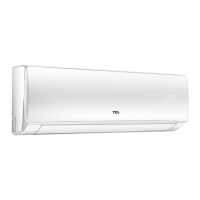







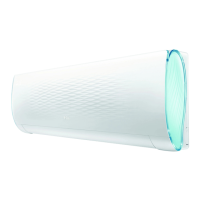
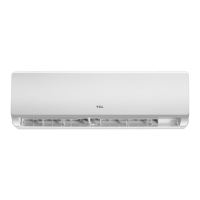
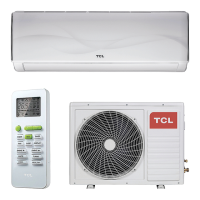
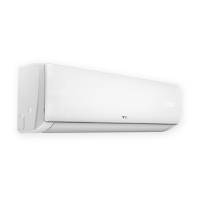
